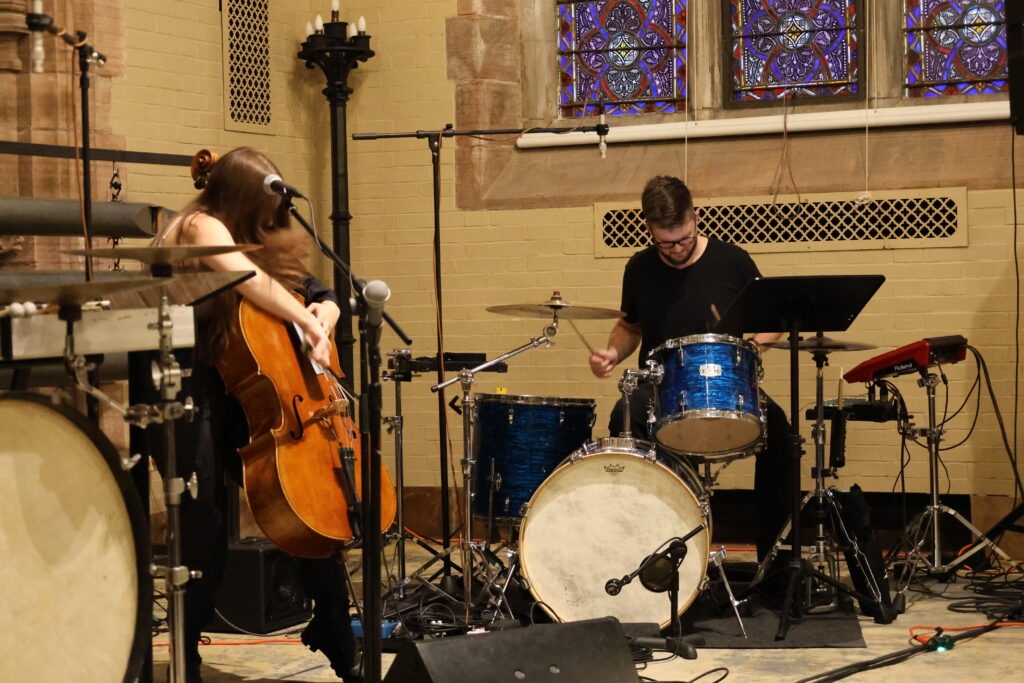Reborn: A Conversation with Artist-in-Residence Eden Rayz
Jessica Bussmann March 16, 2024 Art

In 2023, we welcomed seven Artists-in-Residence to create original works inspired by their experiences at Mount Auburn. Meet composer and musician Eden Rayz. [above photo by Artist-in-Residence Billy Hickey]
You are a composer, cellist, and freelance private music teacher with a Master’s degree in music composition and theory from the Boston Conservatory at Berklee. You are also an extreme vocalist, cellist, and lyricist for a death metal band. How would you describe your work as a musician?
Right now, my work is centered around expanding the functionality of listening experiences as individual and community rituals. With the musical death awareness meditation “Nothingness is Impossible,” listeners are invited to meditate on their own relationships with death and dying. With “Aboriginal Sensible Muchness,” there’s another invitation to walk, notice, and question why our judgments exist. I judge this oak tree as beautiful, but this dead bird as ugly. Why is that? With “Lux Aeterna (which translates to eternal light),” the work I’m currently writing, the construct of time and our relationships with it will be examined.
None of my works are “passive” – they demand a sensory commitment and personal involvement from the listener. I like to give folks something to chew on. Many describe my work as subversive and intense, and I appreciate that.
For your residency, you’ve spent the last 10 months creating a new multi-part instrument from the recycled Bigelow Chapel pipe organ. What has it been like to write music for an instrument no one has ever heard or seen before?
I’m not an engineer, luthier, acoustician, or anything like that, but I’m a dang good project manager. It’s been a welcome challenge to learn the fundamentals of sciencey things in order to make this work. Every day designing is a thought experiment, and I’ve failed at it more times than I can count, which I admittedly really enjoy. Thankfully I’ve had so many great modern examples to look toward – there really is an instrument design renaissance happening right now, and I’ve gotten a lot of great advice from friends and colleagues along the way.
It kind of feels like a trust fall – I have an inkling of what it will sound like, but I have to allow the music to sort of write itself at times. It’s not linear, like writing sheet music.
Your Musical Death Awareness events in October 2023 and March 2024 included meditations on climate grief. How does your appreciation for the natural world inform your creative work?
Like so many of us, I’m constantly going through cycles of grief watching what humans have done and are doing to accelerate this massive shift in life and landscape. It’s that old adage, “because I love, I grieve.” Coming to Mount Auburn is so bittersweet – as I walk, I see these absolutely remarkable blooms, but they shouldn’t be there yet. I rush over to see the snowfall on the tombs because I don’t know the next time this will happen. It’s hard not to cling onto these moments, so I attempt to preserve them in sound, another transient thing.
As you near the end of your artist residency at Mount Auburn, what are the major takeaways of the experience for you?
I’ve met so many remarkable souls here that I know will remain in my life for a very long time. The community of artists built by the program doesn’t end with the end of the residency. Watching the staff do what they do, from making huge events and artist residencies happen (thanks Julie-Anne and Amelia!), to directing burials and cremations (Roy Hawes and Bethany Rhykus), to helping volunteers connect more deeply with the land and history (Katelyn Leaird), and so many more, it’s really been a ton of fun to have a window into the sausage making.
What the Friends of Mount Auburn have done by building this artist residency program should serve as a model for what’s possible when great institutions commit to cultural advancement, especially here in Boston/Cambridge. It’s so needed and so very appreciated!
Check out these upcoming events with Eden!
Nothingness is Impossible: A Musical Death Awareness Meditation
Artist-in-Residence musician Eden Rayz and end-of-life support person Madelaine Ripley will guide guests through a meditation around the concept of “nothingness” accompanied by an ambient soundscape.
Saturday, March 23, 4 PM





Comments